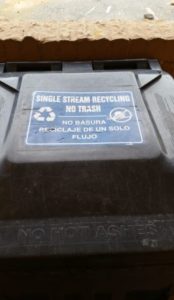WEST LONG BRANCH, N.J.–“I think it’s scary to be living [in New Jersey] with the constant fear of things like Hurricane Sandy,” said Dr. Catherine Duckett, Interim Dean of the School of Science at Monmouth University and professor of the Perspectives in the Science and Politics of Climate Change class with Honors School Dean Kevin Dooley.
“In the last century, between 1900 and 1950, sea level rose 1mm per year, between 1950 until about 1990, it rose 2mm per year, and by 2010, it was rising about 3mm per year,” she continued. “And it’s not going down. The question is, how fast is it going up?”
Sea level rise, among other climate change issues, are of major concern when discussing the future of the earth. The United States Environmental Protection Agency concluded about a month ago that increasing greenhouse gas concentrations will increase Earth’s average temperature, impact precipitation patterns and amounts, and reduce ice, snow and permafrost. It will also raise sea levels, increase ocean acidity, increase frequency, intensity and duration of extreme weather events, alter ecosystems, and increase human health risks.
Thus, more heat waves, floods, hurricanes, and similar phenomena will result from increased average temperatures.
Taylor Bernosky, senior math and music performance major currently enrolled in Dean Duckett and Dean Dooley’s Perspectives class, discovered that by the 2020s, the mean annual temperature in New Jersey will have increased 1.5 to 3 degrees Fahrenheit above the statewide baseline average of 52.7 degrees Fahrenheit.
Bernosky said that by the 2050s, it will be up 3 to 5 degrees Fahrenheit, and by the 2080s, it will be 4 to 7.5 degrees Fahrenheit warmer than today.
Increased flooding may be of greater concern for many New Jerseyans located along the coast. A study conducted by The Union of Concerned Scientists found that 32 flooding events already occur annually in Atlantic City, 41 in Cape May, and 33 in Sandy Hook.

Bernosky stated that New Jersey should plan for at least 1m of rise in sea level by the end of the twenty-first century.
This rise in sea level will cause many financial burdens, including infrastructure and property costs associated with damage from floods, droughts, wildfires, and extreme storms, a loss in productivity in daily lives as well as in trade, transportation, agriculture, fisheries, energy production, and tourism industries, mass migration and security threats, coping costs, and costs for rebuilding after disasters.
“Simply changing the way we eat, how we live, and how we get around, can play a role in slowing down climate change,” added Bernosky.
But in light of these statistics, the average person might ask: “What I do won’t matter unless everyone else does it, so how can I make a difference by myself?”
It can seem like the problem is too big to solve alone. However, even the smallest lifestyle changes to reduce your carbon footprint can impact climate change–even without the actions of others.
“Actions we take now can slow things a lot,” reassured Dean Duckett. “This is really something where we’re all in it together.”
Here are a few recommendations for combating climate change based on the Perspectives class:
1. Always keep transportation and the carbon footprint in mind.
If you lower your carbon footprint by reducing the amount of energy used and greenhouse gases emitted, you can slow down the speed at which temperatures are increasing and sea level is rising. The EPA recommends using their Household Carbon Footprint Calculator, which will figure out how much greenhouse gas emissions you amass from energy use, transportation, and waste disposal.
Dean Dooley believes people need to rethink their carbon footprint, especially when in terms of the kind of car, the frequency, and the distance they drive.
Deans Dooley and Duckett both recommend carpooling or choosing alternative methods of transportation like walking, riding a bike, carpooling, taking public transportation, choosing to drive a low-carbon vehicle. Bernosky found that this, as well as keeping your car properly maintained, leads to a significant reduction in carbon footprints.
2. Remember to turn off the lights.
Something as simple as remembering to turn off the lights when you are not in the room can not only save you money in energy costs as Dean Dooley pointed out, but it can also help the environment by using less energy and emitting less greenhouse gas emissions. Consider it a way of giving your parents one less thing to nag you about, that you can also feel good about doing.
3. Watch what you eat.
Dean Duckett suggested that eating less meat can reduce your carbon footprint because it uses less energy. Comparing a vegetarian diet to a carnivorous one, more resources are used and more greenhouse gases are produced when humans eat animals that are fed plants. It is better for the climate to simply get the plant nutrients directly from the source.
The animals that humans tend to eat, specifically cattle, produce a methane byproduct from the plants they eat. This has 20 times the heat-trapping ability of carbon, a gas that is already causing climate change problems relative to rising temperatures and sea level rise.
The UN claims that 15 percent of global emissions comes from livestock. The amount of methane a single cow emits is equivalent to the amount of emissions from a car burning 235 gallons of gas. With the National Cattlemen’s Beef Association USA finding cattle inventory at 89.8 million at the beginning of this year, that is the equivalent of burning almost 7 trillion gallons worth of gasoline this year.
4. Air dry versus tumble dry.
Dryers are energy hogs. Hang drying whenever possible can lower the amount of energy used and lower your carbon footprint significantly. While living in a dorm, air drying clothes on hangers can work as well.
“A lot of students could use a clothes line rather than go to a laundromat,” added Dean Duckett.
5. Recycle, recycle, recycle.
Dean Duckett recommended recycling everything and anything possible.
“Simply reducing, reusing, and recycling can help to conserve energy, and reduce pollution and greenhouse gas emissions,” said Bernosky. “You can recycle newspapers, beverage containers, papers, and other goods through your town’s recycling program, and you can also compost your food and yard waste to reduce the amount of garbage being sent to landfills and reduce greenhouse gas emissions.”
6. Insulate and seal your windows.
Dean Dooley, along with several other experts, believes that maintaining the quality of windows can reduce energy usage and ultimately lower energy costs. You can reduce drafts and air leaks with things like caulk, insulation, and weather stripping.
Some states even offer incentives in order to get people to do this. Under New Jersey’s Clean Energy Program is the New Jersey Home Performance with Energy Star Program, which offers financial incentives for making home improvements that are energy efficient. For college students, a very inexpensive way to seal your windows could be to purchase a weather strip at a store like Home Depot, or online.

7. Join and donate to conservation organizations.
One of the easiest ways to get informed and stay updated on real climate change issues is to join conservation organizations that raise awareness about climate change through political action. Anyone can do this by joining the organizations’ mailing lists on their websites.
Many conservation organizations also use social media to make people aware of climate change issues. Dean Duckett recommended following the World Wildlife Fund, one of the organizations she personally donates to, on Facebook and Twitter, as well as The League of Conservation Voters.
“I’ve been impressed with The League of Conservation Voters’ use of social media. They can get me petitions I didn’t know about quicker than other people,” said Dean Duckett. “If you do have extra money, invest in these charities because at this point, I think it’s an investment, not just a gift.”
8. Spread the word and educate.
Something as simple as telling family and friends about the issues of climate change, the predictions, and how lowering greenhouse gas emissions can significantly help the environment as well. The EPA recommends spreading the word that energy efficiency is good for homes financially as well as good for the environment because it lowers greenhouse gas emissions and air pollution.
For college students, Bernosky recommended visiting VoteSmart.org where you can type in your address and find a list of federal and state representatives, their voting records, issue positions–including where they stand on climate change, ratings, and campaign finance.
“One of the most important things you can do is to contact your local, state, or federal representatives. This can be done by either mail, phone call, or an even more effective way is to create an organized petition,” said Bernosky. “Letting your decision-maker know what you think, especially about specific policy proposals being considered, can make a real difference.”
“The Union of Concerned Scientists (UCS) Action Center provides tools and information to take a variety of political actions online and offline,” said Bernosky. “Citizens Climate Lobby arms citizens with the information, skills and opportunities to lobby Congress, state and local officials, and other leaders. 350.org connects activists and organizes climate actions big and small around the world.”
Even celebrities like Katy Perry and Bill Nye “The Science Guy” are making efforts to spread the word about how serious of an issue climate change is. Perry highlights the negative effects it might have on children in the future through organizations such as UNICEF. Nye recently released a book called “Unstoppable,” which discusses ways in which young people can use science to combat climate change now.
Educating others about climate change is something that can be done inside and outside the classroom. It is important to identify the connection between everyday actions and how they affect climate change. Something as simple as turning off the lights when leaving a room or remembering to recycle that potato chip bag after lunch can make a significant different.
When it comes to combating climate change, something is better than nothing.



